You have no items in your shopping cart.
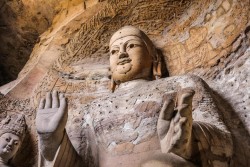

Introducing Datong Yungang Grottoes
Located at the southern foot of the Wuzhou Mountains, the Yungang Grottoes are one of the three most famous ancient Buddhist sculptural sites of China. The others are Longmen Grottoes and Mogao Caves. The Yungang Grottoes stretch for over a kilometer and are etched indelibly into the rock-face. The 252 caves and 51,000 Buddha statues of the Yungang Grottoes were completed in sixty years (460-525); this period marks the peak of development in Buddhist cave art of the Northern Wei Dynasty (386 - 534). When the first emperor assumed the throne, Buddhism flourished and in 460 the monk Tan Yao started the carving of the Five Caves which lasted until the year 465 AD, and the caves are now known as caves 16–20. Their construction was sponsored by the rulers of the Northern Wei Dynasty (386 - 534). . The colossal Buddha images in the first five caves were equated with the first five emperors of the Northern Wei Dynasty (386 - 534), thus emphasizing the political and economic role that the court imposed upon Buddhism. Beginning around the year 471 AD, in a second construction phase that lasted until 494 AD, the twin caves 5/6, 7/8, and 9/10 as well as the caves 11, 12, and probably 13 were constructed under the supervision and support of the imperial court. The imperial patronage ended in 494 AD with the move of the Wei court to the new capital of Luoyang. All other caves emerged under private patronage in a third construction period, lasting until 525, when the construction came to a final halt due to uprisings in the area. The Yungang Grottoes represent the outstanding achievement of Buddhist cave art in China in the 5th and 6th centuries and the power and endurance of Buddhist belief in China.
Datong Yungang Grottoes Fast Facts
• Chinese Name: Yun Gang Shi Ku 云冈石窟
• Best Time to Visit: March to November
• Recommended Visiting Hours: About 2 hours
• Things to Do: Photography, Buddhism, Culture
• Opening Hours: 08:30 to 17:30 from Apr to Oct; 08:30 to 17:00 from Nov to Mar
• Entrance Fee: CNY 120 from Apr to Oct; CNY 100 from Nov to Mar; free for children under 1.2m (3.9ft).
• Address: Wuzhou Mountain, Datong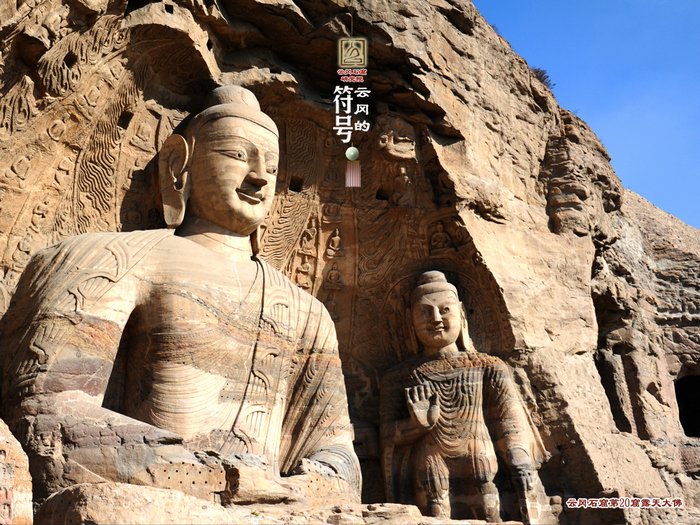
What UNESCO Says of Datong Yungang Grottoes
The massive Yungang Buddhist grottoes were cut from the mid-5th Century to early-6th Century AD. Comprising 252 caves and niches and 51,000 statues within a carved area of 18,000 square meters, the Yungang Grottoes represent the outstanding achievement of Buddhist cave art in China. The Five Caves created by Tan Yao are a classical masterpiece of the first peak of Chinese art, with a strict unity of layout and design. The will of the State is reflected in Buddhist belief in China during the Northern Wei Dynasty since the Grottoes were built with Imperial instructions. While influenced by Buddhist cave art from South and Central Asia, Yungang Grottoes have also interpreted the Buddhist cave art with distinctive Chinese character and local spirit. As a result, Yungang Grottoes have played a vitally important role among early Oriental Buddhist grottoes and had a far-reaching impact on Buddhist cave art in China and East Asia.
What to Expect at Datong Yungang Grottoes
Historically Yungang Grottoes have been divided into three major groups: the east section (caves 1-4), have some interest, but are relatively minor compared to the others; the center section (caves 5-13), with a number of paired caves mostly carved between 462 and 495; and the west section (caves 14-53), constructed during a variety of earlier and later periods, but containing the significant imperial caves (16-20).
Cave No. 5 and No. 6
Cave No. 5 and No. 6 are paired caves carved between 465 - 494. The four-storey wooden structures outside were built in 1651. The 17 meters high sitting Buddha statue of Shakyamuni in Cave No.5 is the largest statue of Yungang Grottoes. Buddha statues and niches framed by carvings of flying apsaras are carved on the walls. One Buddha statue on the western wall has curved eyebrows and straight nose, and happy smile. Cave No. 6 is a cave with central pillar, also known as a stupa temple cave. This cave is richly decorated and is praised as “the most spectacular one in Yungang” and one of the highlights of Chinese art. A 15 meter high, 2-storeyed square pagoda stands at the center of Cave No. 6. Directional Buddhas face outwards from its central pillar; the niches are framed by carvings of flying apsaras. Meanwhile, Jataka of Buddhism is carved on the walls.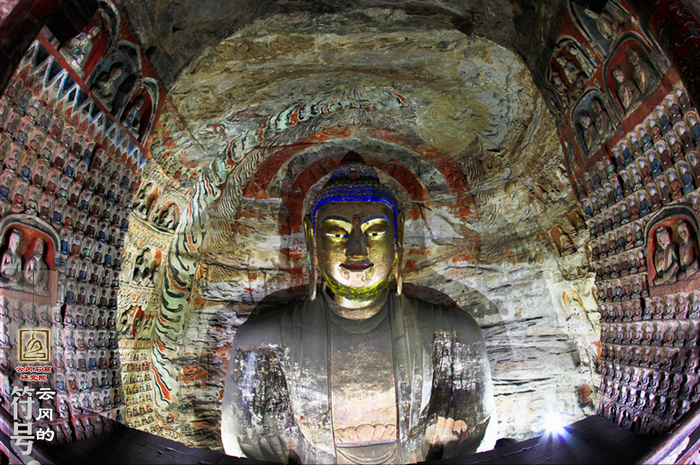
Cave No. 9, 10, 11, 12, 13
Cave No. 9, 10, 11, 12 & 13 are commonly known as Five Lotus Cave. Cave No. 9 and 10 are paired caves, each with a front room and a back room, similar arrangement as the Chinese palace hall. Walls of Cave No. 9 & 10 are covered with layers of niches, subjects of which are from the Lotus Sutra. Among the five caves, Cave No. 12 may be the most striking one. This cave is called the Cave of Music. The top section of the north wall are carved with 14 celestial musicians, whistling, beating drums, playing panpipe, lute, flute, harp, zither, Bili, harp, waist drum, conch and other musical instruments respectively. On the lintel of the entrance are a group of celestial dancers. The musical instruments, their playing style as well as the types of band combination reveal the court orchestra of Northern Wei Dynasty (386 - 534).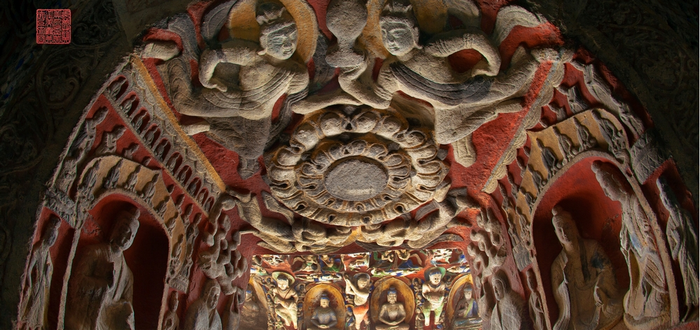
Cave No. 16, 17, 18, 19, 20
Cave No. 16-20 are the earlier caves of Yungang grottoes and named Five Caves of Tan Yao. They were built between 460 and 470 by the famous monk named Tan Yao, who oversaw their construction in his capacity as imperially-appointed supervisor of the carving of Yungang grottoes. Five statues of the first five Emperors of the Northern Wei Dynasty were depicted as living Buddhas. The 14m-tall seated Buddha of Cave 20 is an icon of Chinese art, comparable to the colossal exposed Buddhas of Dunhuang and Longmen. It was originally flanked by a pair of smaller standing buddhas, of which only the eastern figure now remains. Square holes in the back wall once socketed the beams of a wooden protective facade, now long-gone. The lower parts of the figures have spalled away, a fate shared by many sculptures at Yungang; its soft sandstone rock was ideal for fine carving, evident in the detailing of the Buddha's robe and mandorla, but susceptible to destructive alternations of temperature, wind, and weather. Their faces, although partially restored, have retained the non-Chinese physiognomy that was inherited from their predecessors at Dunhuang; likewise the drapery of their robes is Central Asian, rather than Chinese. 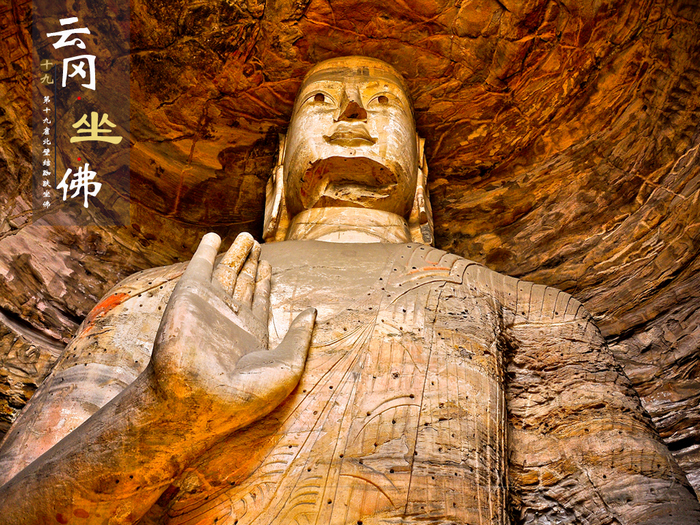
How to Get to Datong Yungang Grottoes
• Yungang Grottoes are located 23km away from Datong city center, about 30 minutes' drive.
• Datong local bus No. 3 terminates at Yungang Grottoes.
• Rent a car/bus from GGC to enjoy a hassle free private transfer from hotels in Datong to Yungang Grottoes.